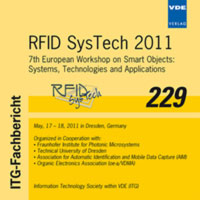Range Extension of an ISO/IEC 14443 type A RFID System with Actively Emulating Load Modulation
Konferenz: RFID SysTech 2011 - 7th European Workshop on Smart Objects: Systems, Technologies and Applications
17.05.2011 - 18.05.2011 in Dresden, Germany
Tagungsband: RFID SysTech 2011
Seiten: 10Sprache: EnglischTyp: PDF
Persönliche VDE-Mitglieder erhalten auf diesen Artikel 10% Rabatt
Autoren:
Finkenzeller, Klaus (Giesecke & Devrient GmbH, Prinzregentenstraße 159, 81607 München, Germany)
Pfeiffer, Florian (perisens GmbH, Arcistr. 21, 80333 München, Germany)
Biebl, Erwin (Fachgebiet Höchstfrequenztechnik der Technischen Universität München, Arcistr. 21, 80333 München,80333 München, Germany)
Inhalt:
Originally designed for contactless smart cards in the form factor ID1, today ISO/IEC 14443 finds new applications in an increasing number of different form factors. Most famous among the new form factors are applications such as the electronic passport (e-passport) or contactless credit cards in a form factor that is only half or one third as large ("key fob") as ID1. The need of increasingly smaller form factors, however, more often leads to problems in the field, because the small transponder cannot always be read out reliably. This has led to a new type of a battery powered transponder, actively emulating load modulation, to enhance the operating distance. Whereas ISO/IEC 14443 focuses on very small antennas and small transmission power to allow reliable communication distances of a few centimetres, we were looking in the opposite direction. Using quite large antennas and huge transmission power we achieved communication distances in the range of a few meters. We also learned, however, that the effort spent to enhance the reading range increases drastically with each additional meter, quickly ending up with equipment like a "broadcast radio station". The issue presented in this paper is not linked to a future application, but describes the practical limits of a potential attack scenario.


